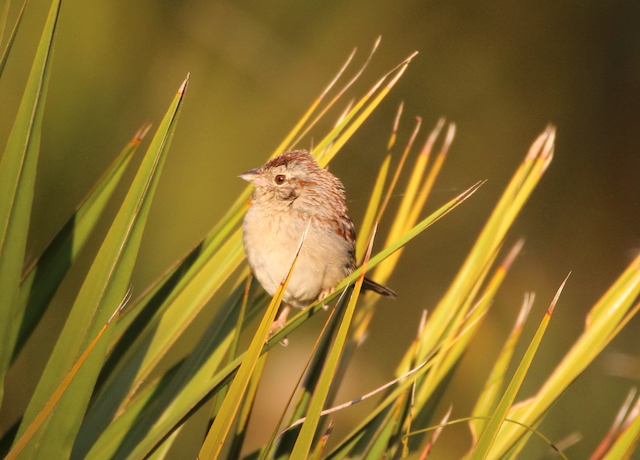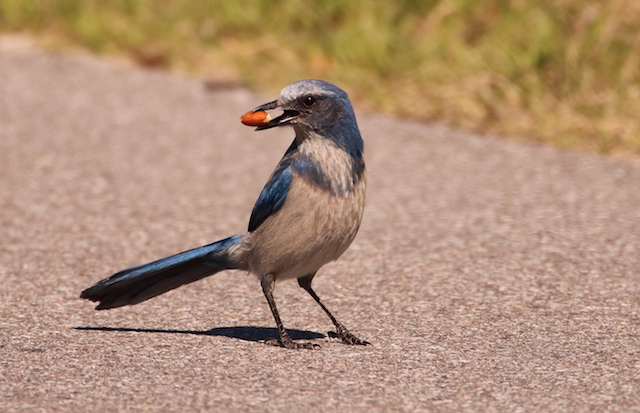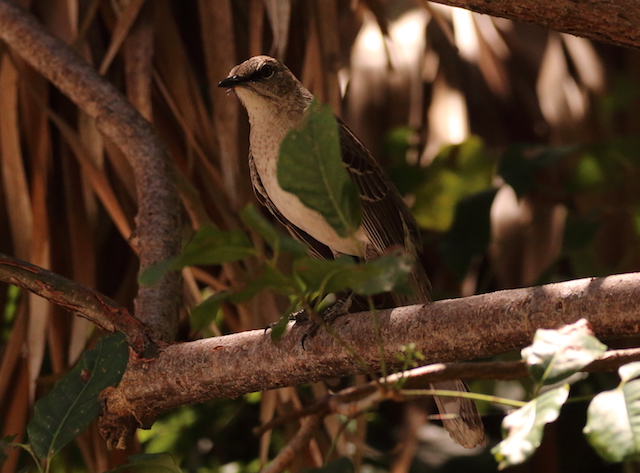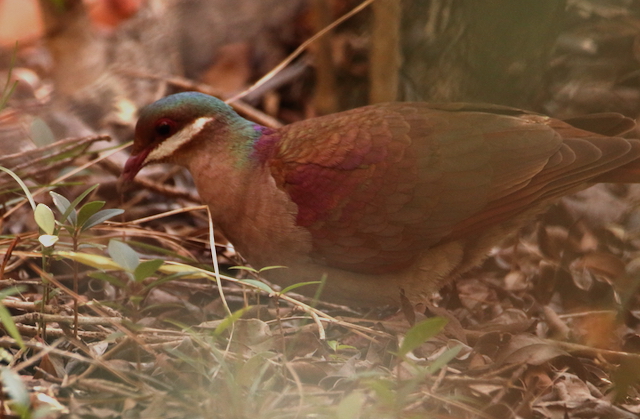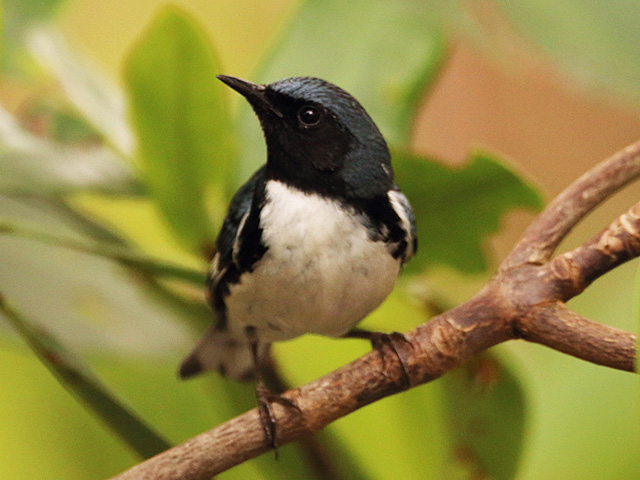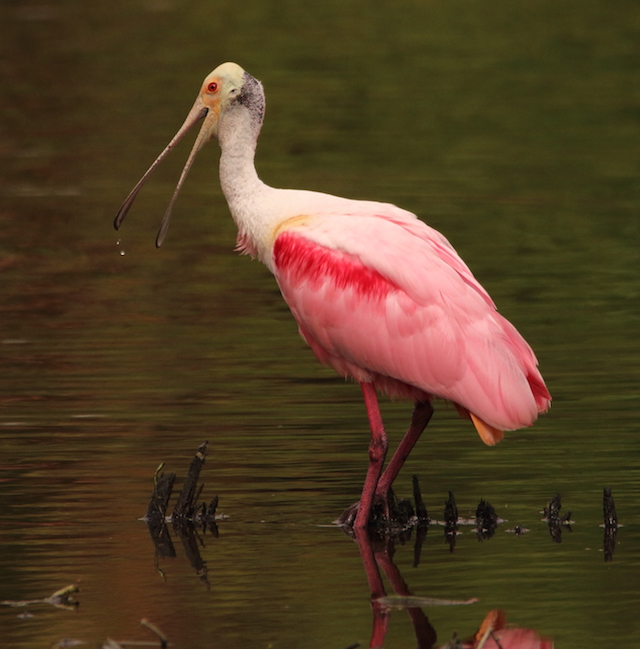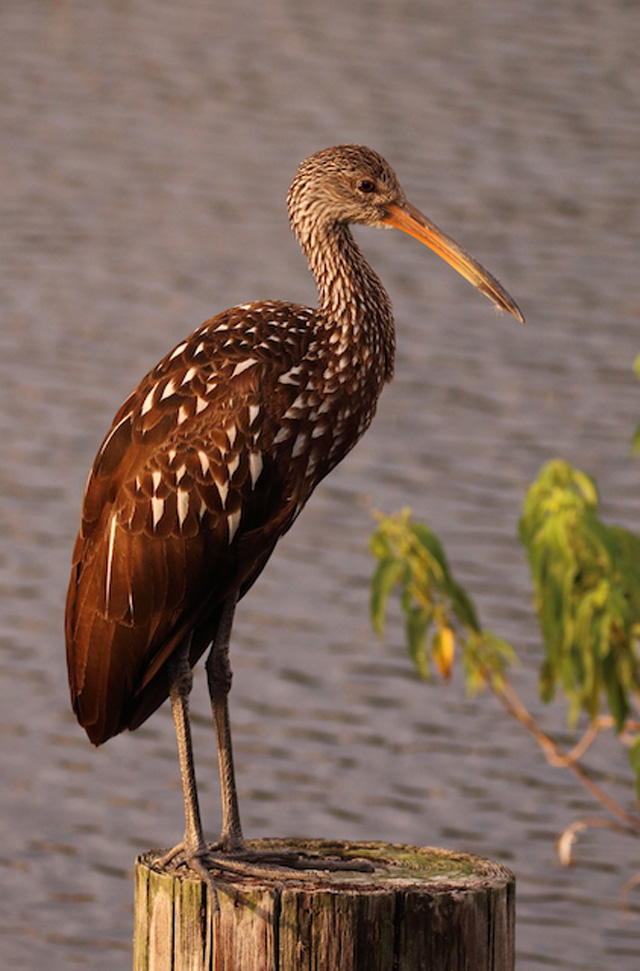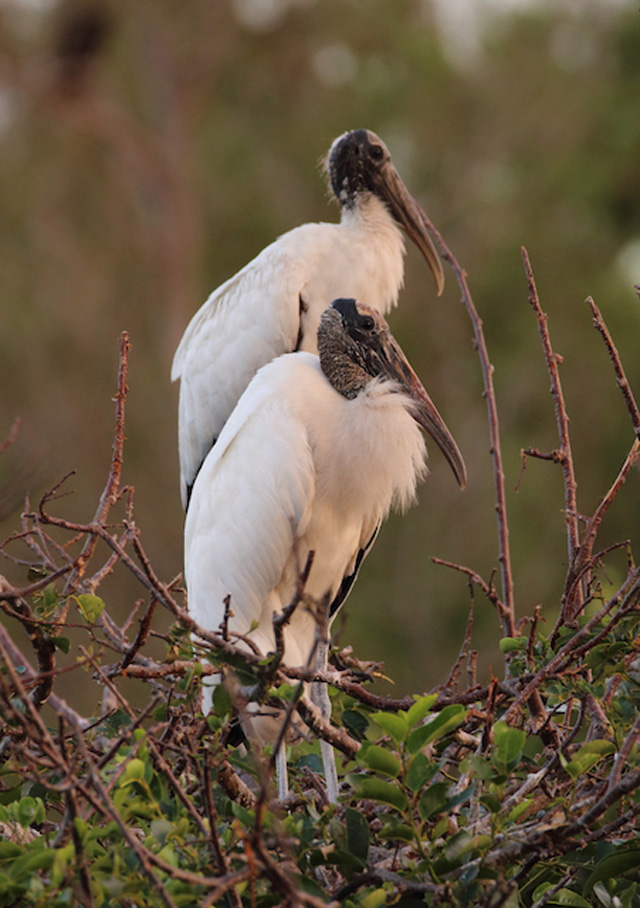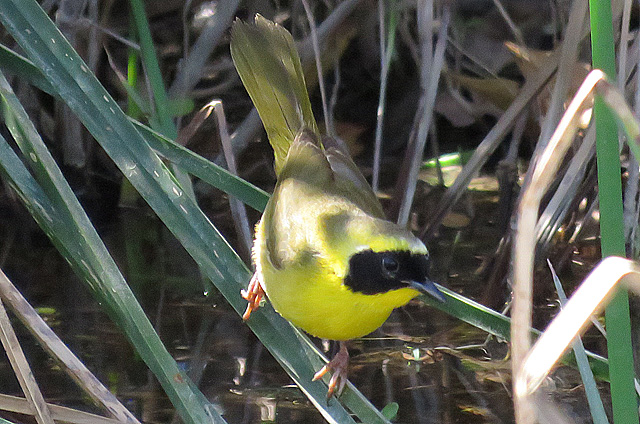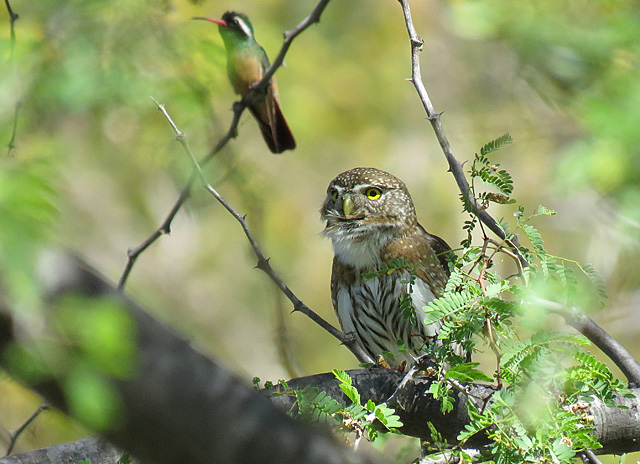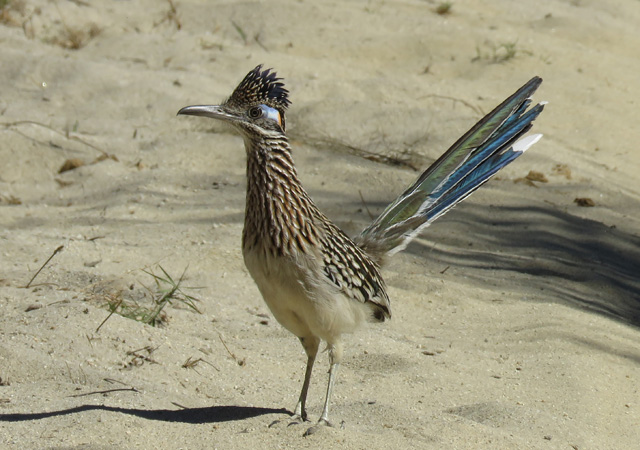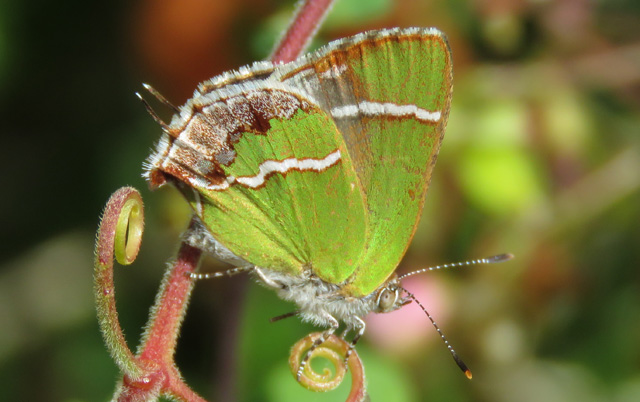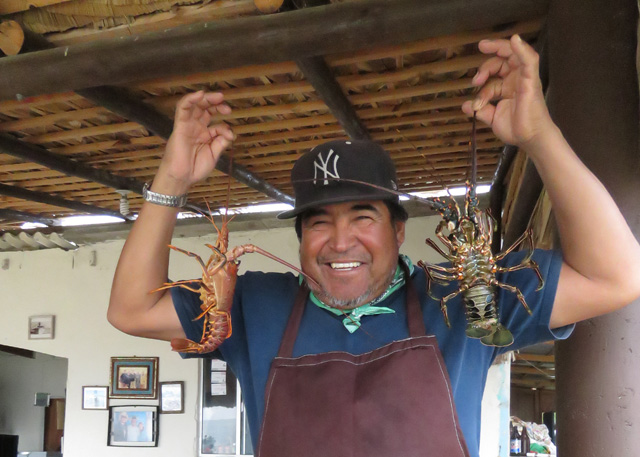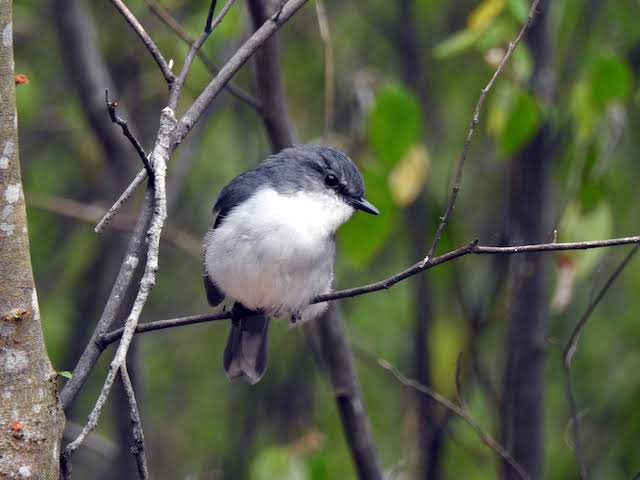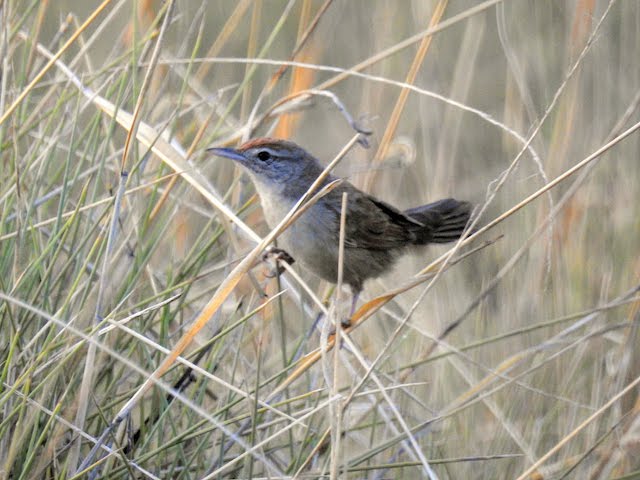From the Field
May 22:
Luke Seitz on his recent tour, Guatemala
Our tour to Guatemala this year was nothing short of spectacular – it’s difficult to articulate just how much fun we had. Of course, I always try to make my tours sound as good as possible in the write-up...maybe embellishing just a little bit, or glossing over the more challenging days. For this tour, the only challenge will be finding enough unique superlatives to use in describing our outrageous views of rare and difficult birds, the great sense of humor shared by everyone in the group, and the memories of a trip that will go down as one of the best I’ll ever do!
We started off with some easy highland birding around the historic city of Antigua (with regional specialties like Blue-throated Motmot, Blue-and-white Mockingbird, and our first Pink-headed Warblers) before heading west towards Huehuetenango. The weather on the high plateau is unpredictable but our time here was beautiful, allowing for a full morning of birding among the pines and junipers with abundant Goldman’s Warblers…
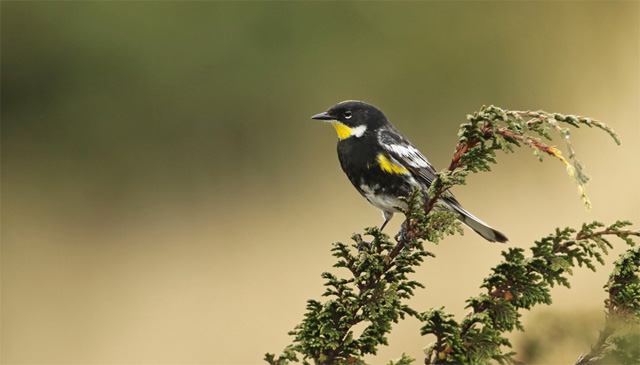
Goldman's Warbler
...and before long, it was time to head even further west, birding for two days on the slopes of Volcán Tacaná. The bamboo was seeding, so amazingly, we enjoyed mega views of a singing Maroon-chested Ground-Dove in the scope for fifteen minutes! Wow – arguably one of the most difficult and unpredictable species in the Neotropics.
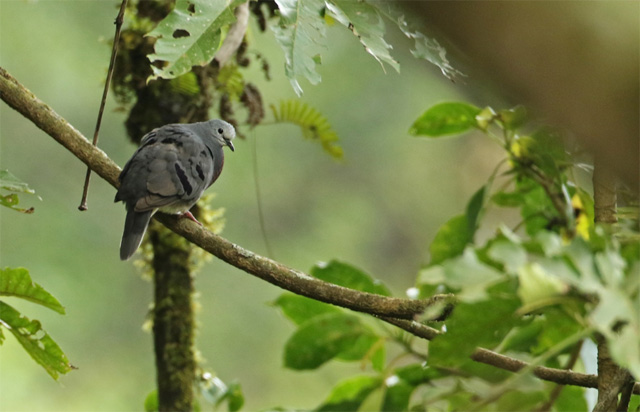
Maroon-chested Ground-Dove
One of the most sought-after species for any birder visiting Guatemala is the unique Pink-headed Warbler. It’s a fairly common bird, and it’s not too difficult to find a couple pairs in a morning of birding…but we were hardly expecting to see over SIXTY individuals in just a couple hours! We didn’t get bored of this stunner, though.
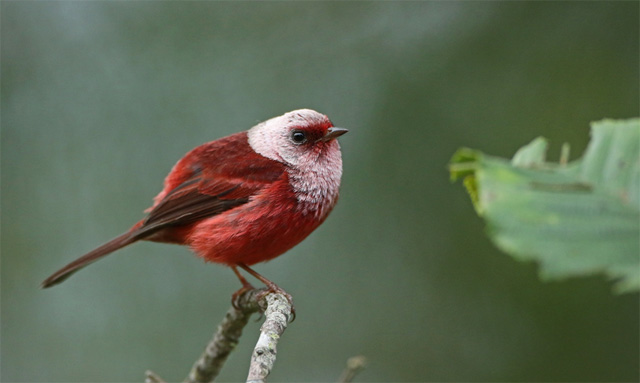
Pink-headed Warbler
Heading back east, we worked our way through various other birding locations in the highlands, with highlights too numerous to list…Fulvous Owls perched right over our heads, Azure-rumped Tanager singing in the scope, Bar-winged Orioles, Black-crested Coquette, outrageous views of White-faced and White-eared Ground-Sparrows, Slender Sheartail, Belted Flycatcher…our luck simply never ended. As our time in the highlands wrapped up, we looked forward to the Tikal extension…would our perfect trip continue? Unequivocally, yes, with cooperative Pheasant Cuckoos and Tody Motmots…
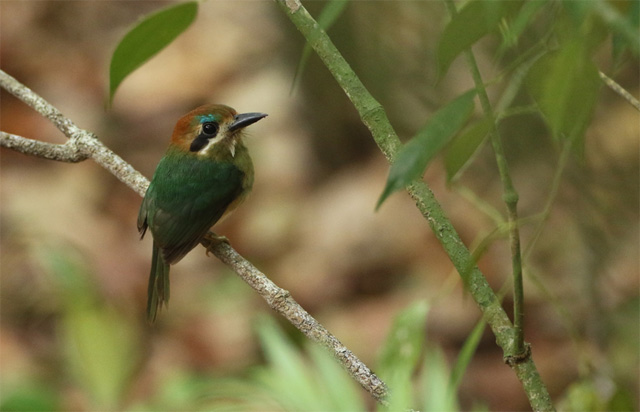
Tody Motmot
…and, most unexpected of all, JAGUAR! An adult quickly crossed the road in front of us, followed by this youngster, which paused for a solid 15 seconds as our group stared in disbelief. It’s difficult to describe the adrenaline rush and excitement that come with seeing a big cat in the Neotropics. Heart pounding, goosebumps, and nausea were all among my symptoms. Wow – I wonder what next year’s tour will hold?!
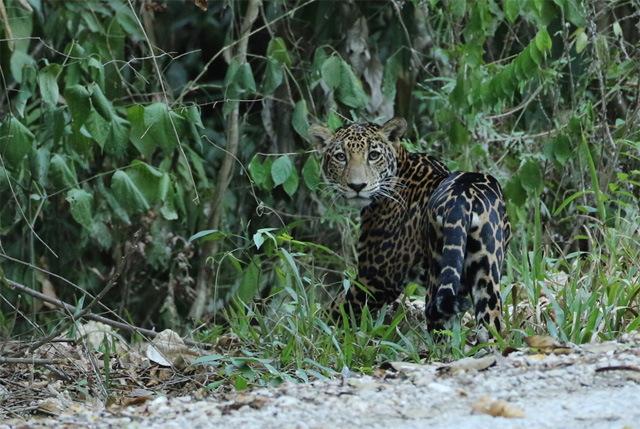
Jaguar!!
May 13:
Luke Seitz on his recent tour, Mexico: Oaxaca and Western Chiapas
Our tour through the varied habitats of western Chiapas and Oaxaca was, as usual, packed with memorable bird sightings and excellent Mexican food but a fun group helped a lot too.. Starting in the bustling city of Tuxtla Gutierrez, one of many highlights was the magnificent Sumidero Canyon……complete with views of the perky Belted Flycatcher.
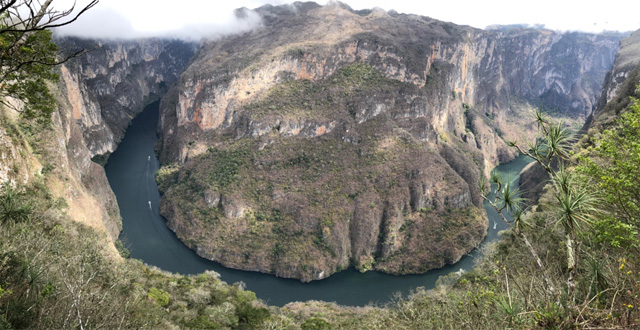
Sumidero Canyon
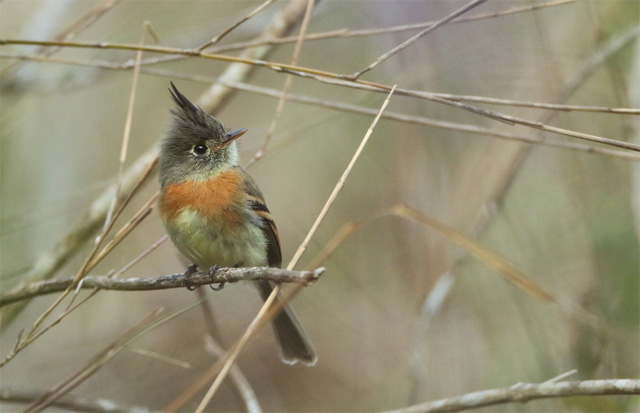
Belted Flytcatcher
We then dropped down the Pacific slope, making sure to stop in the foothills above Arriaga to see the stunning and very range-restricted Rosita’s (or Rose-bellied) Bunting…one of the top birds of the tour, for sure!
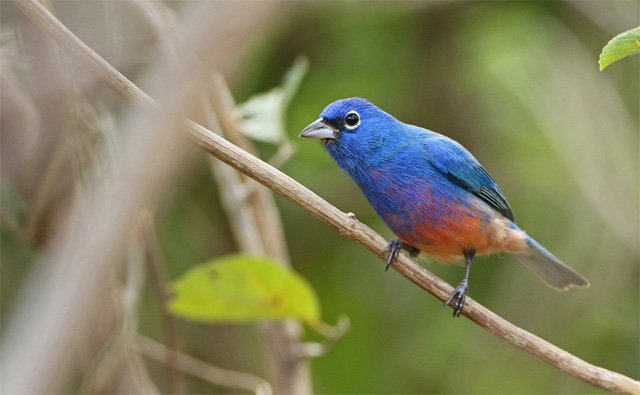
Rosita's Bunting
We spent some time exploring the lowlands around Puerto Arista before heading west across the isthmus of Tehuantepec, where habitats and birds changed accordingly. One of the targets near Tehuantepec is Sumichrast’s (or Cinnamon-tailed) Sparrow, which performed very well alongside Orange-breasted Buntings and Citreoline Trogons.
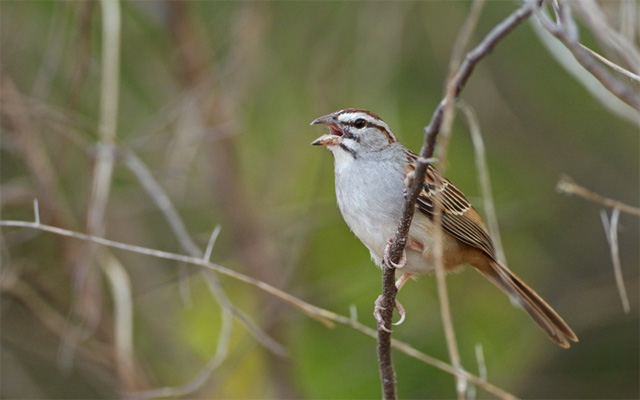
Sumichrast’s Sparrow
The tour finished in the beautiful Oaxaca Valley, which is home to a whole new suite of special birds (and tasty mole sauce and string cheese, among other food…yum). Our three days here sampled a variety of habitats, including cool pine-oak forest home to Red Warbler and Fulvous Owl (one of which nearly took our heads off – wow!) and scrubby oak woodlands with Slaty Vireo and Ocellated Thrasher. I don’t have many bird photos from this part of the tour, but I made sure to document one of our picnic lunches, complete with fresh guacamole – this was right before a pair of Sclater’s (Strong-billed) Woodcreepers came zooming in to the pine trees above our heads! It was an action-packed ten days, and suddenly the farewell dinner was upon us – I’m already looking forward to next year!
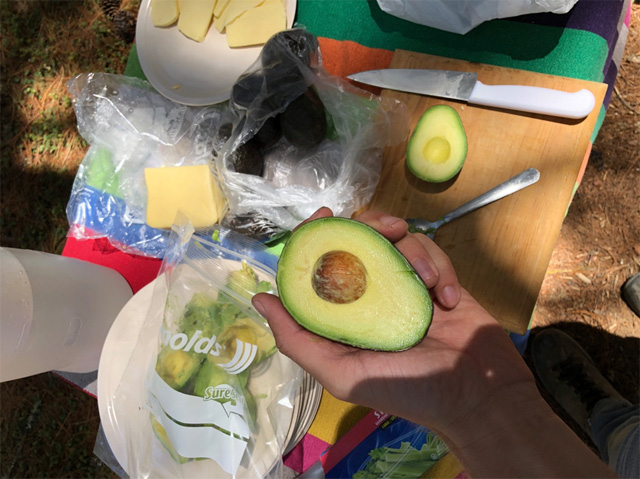
A picnic lunch in the making...
May 2:
Gavin Bieber and Evan Obercian on their recent tour, Florida: The South, the Keys and the Dry Tortugas
We started with a day in the dry pine forests and upland scrub of the central peninsula with fantastic views of a perched Bachman’s Sparrow, and a cooperative Florida Scrub Jay.
Bachman's Sparrow
Florida Scrub Jay
Day two found us successfully chasing some Caribbean strays, with excellent views of Bahama Mockingbird and Key West Quail-Dove.
Bahama Mockingbird
Key West Quail-Dove
A day trip out to the unique Fort Jefferson in the Dry Tortugas was sunny and hot but still produced 17 species of warblers and good views of both Masked and Brown Boobies.
Black-throated Blue Warbler
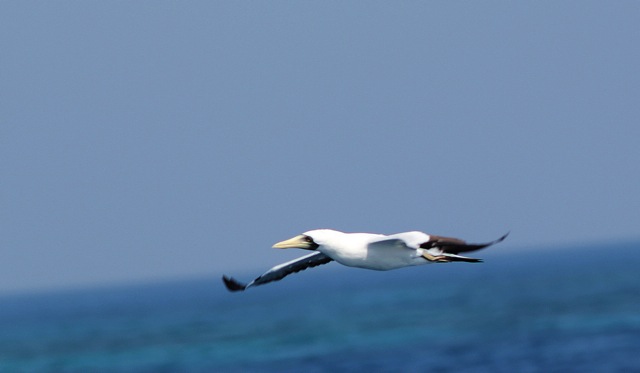
Masked Booby
We ended the tour north of Miami with a wonderful visit to a large wetland providing close up views of a wide array of waterbirds, from glowing Roseate Spoonbills to the more sedately coloured Limpkin and lots of nesting species such as these Wood Storks.
Roseate Spoonbill
Limpkin
Wood Stork
As always, Florida isn’t all about the birds, and this year we enjoyed excellent views of lolling West Indian Manatees, and a wealth of reptiles, amphibians, butterflies and even fish! I look forward to this tour every year, as it combines great eastern migration birding with Florida's highlight breeding species and even the occasional stray rarities from the nearby Caribbean.
April 21:
Gavin Bieber on his recent tour, Panama: Spring at the Canopy Tower
It is always a pleasure to return to the Canopy Tower and the Canopy Lodge, surrounded as they are by an excellent mix of habitats and a great diversity of birds. Some of the highlights this year around the tower included very confiding male Spot-crowned Ant-Vireo and Black-breasted Puffbird, a fantastic showing of the often reclusive Streak-chested Antpitta, displaying male Golden-collared Manakins, a dizzying array of hummingbirds including the superlative Crowned Woodnymph and even a group of Panamanian Night Monkeys peering out of their lofty roost cavity.
Thanks to David Fisher for all the images below except for Gavin's Night Monkeys.

Spot-crowned Antvireo
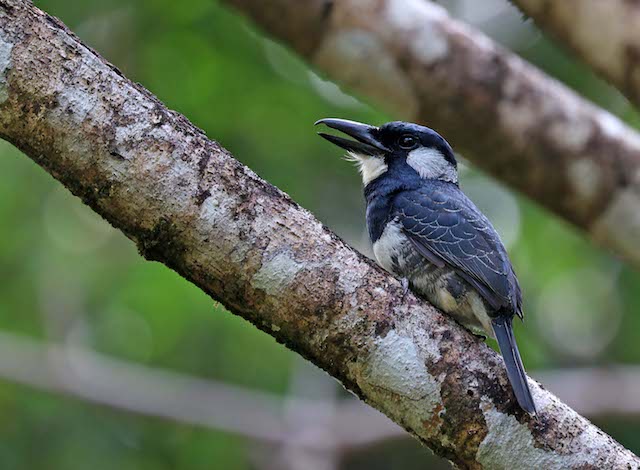
Black-breasted Puffbird
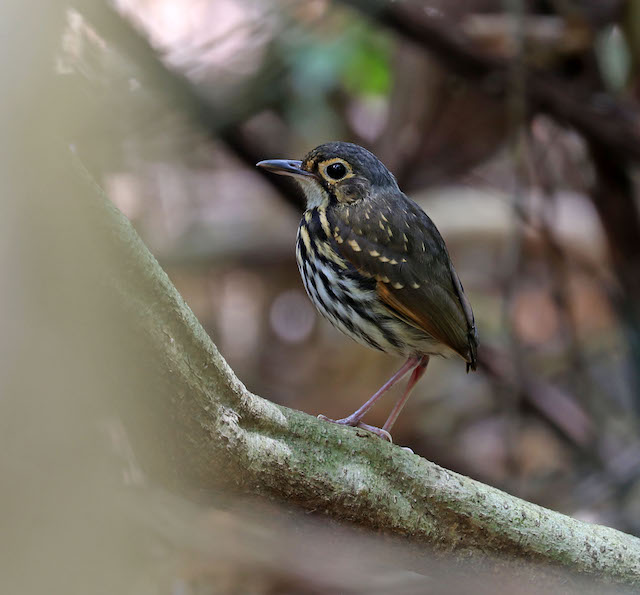
Streak-chested Antpitta
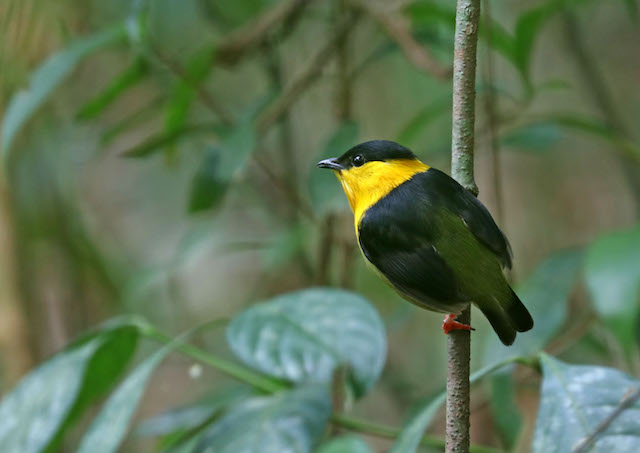
Golden-collared Manakin
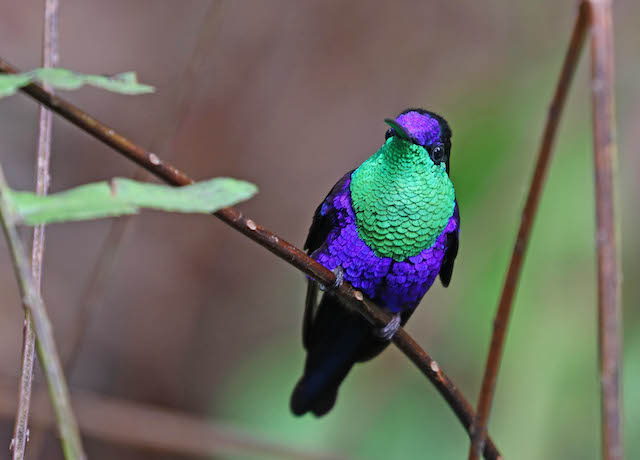
Crowned Woodnymph
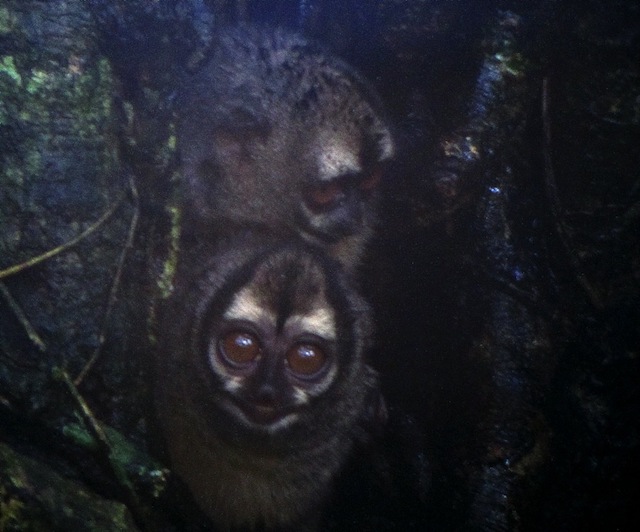
Panamanian Night Monkey
Around the more montane forests surrounding the lodge we added nearly 100 more species to the triplist, with a few of the highlights being lengthy views of a pair of Brown-billed Scythebills and daily encounters with gaudy Orange-billed Sparrows.
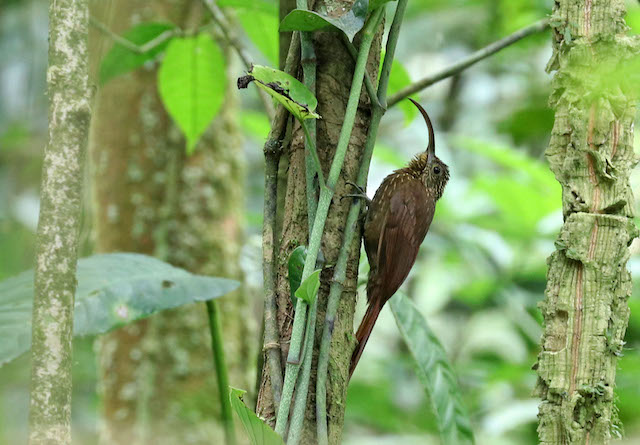
Brown-billed Scythebill
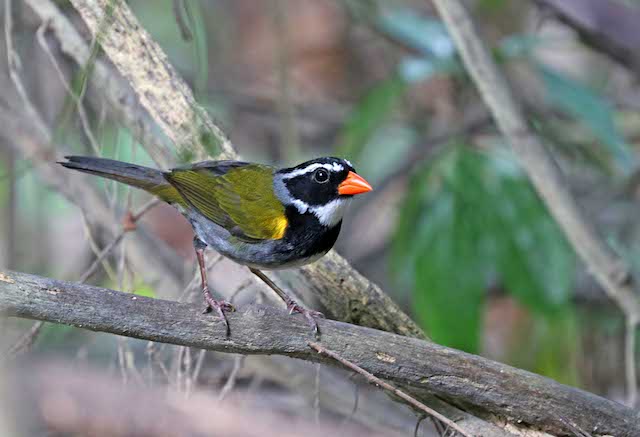
Orange-billed Sparrow
In all we tallied just shy of 370 species of birds, including an amazing 50 species of flycatchers, as well as 15 mammals and 16 species of reptiles and amphibians in 10 days in the field! This tour continues to impress me, as the diversity and richness of the region, paired with ease of access and the comforts of the lodge make for a truly wonderful experience.
April 1:
Rich Hoyer on his Mar. 2019 tour to Baja California's Cape Region
Gorgeous weather, delicious food, amazing scenery, and a great group were highlights of this year’s Baja California tour. Belding’s Yellowthroat was one of the few serious target birds we hoped to see, and it was one of the first birds on our first morning at the San José Estuary.
Belding's Yellowthroat
Another hoped-for bird that showed well was the endemic subspecies of Northern Pygmy-Owl, which was mobbed by the endemic Xantus’s Hummingbird, providing for a very rare photo opportunity.
Northern Pygmy-Owl (Cape), Xantus's Hummingbird
Our non-endemic bird highlights were many – including an incredibly confiding and curious Greater Roadrunner that approached within a few yards of the group. A video of the bird can also be seen here: https://youtu.be/-6mniFw5mkM
Greater Roadrunner
The natural history of the Baja California peninsula is fascinating and beautiful. Rains earlier in the season had allowed for lush growth that attracted many butterflies, including this gorgeous Silver-banded Hairstreak.
Chlorostrymon simaethis sarita
One of the highlights was our whale watching boat trip on Magdalena Bay. Several whales cavorted near our boats, and one even swam right underneath us only a few feet deep.
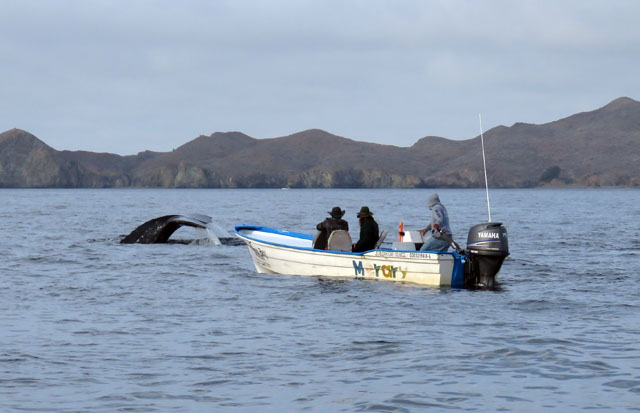
Whale Watching on Bahia Magdalena
The food everywhere was excellent, especially the perfectly fresh seafood. Here at Puerto Magdalena, the chef shows us our spiny lobster lunch that he was about to prepare, perhaps the best meal of the trip.
Lunch at Magdalena Fishing Village.JPG
March 26:
Jake Mohlmann, Evan Obercian and Ethan Kistler on their just-completed tour, Nebraska: The Sandhills and the Platte River
We just finished covering 1,000 miles of mostly paved roads through America’s Heartland. Some of the worst flooding in the history of the state was witnessed as the mighty Missouri and Platte Rivers swelled to 8 feet over flood stage leaving lots of people homeless. On top of that a rare 'Bomb Cyclone' had just passed through leaving any bits inland open water completely frozen. Despite all this the tour went on with enthusiasm as we enjoyed birds en mass all week.
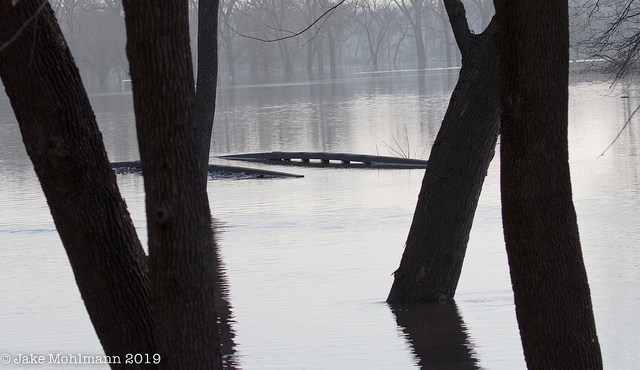
The rails of a bike path bridge show the high flood waters.
Every day we had a chance to run into several sparrow species including flocks of Tree, skulky Song, and stealthy Swamp Sparrows in the marsh vegetation. By far the highlight of the sparrow show was a very confiding Harris’s Sparrow that sat close by and sang at length for our delighted group. Also, despite most of the woods being flooded some early arrival Red-headed Woodpeckers greeted us at Fontanelle Forest.
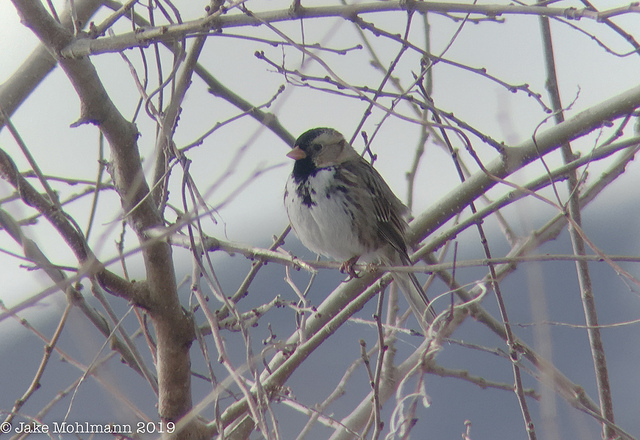
This male Harris’s Sparrow was a highlight of the tour.
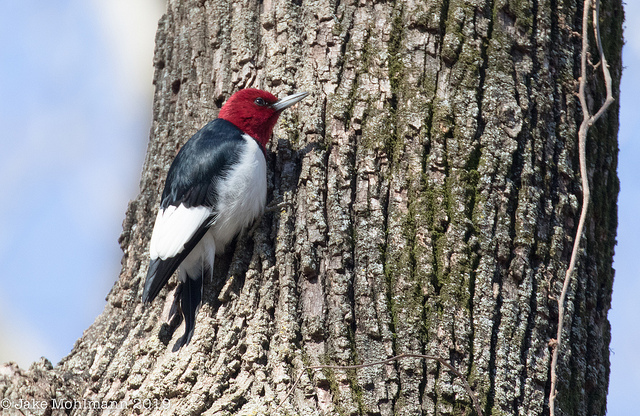
Red-headed Woodpeckers have already arrived.
Scattered throughout this region are scads of ponds and lakes which held a nice array of waterfowl with great looks at Wood Duck, Bufflehead, Common Goldeneye, and all three Merganser species. By far the most abundant fowl were the geese. Probably due to the recent weeks of plunging temperatures and lack of forage the Snow, Ross’s, Cackling, and Greater White-fronted Geese were passing over en mass and we were surprised to look up wherever we went and see hundreds pouring overhead.
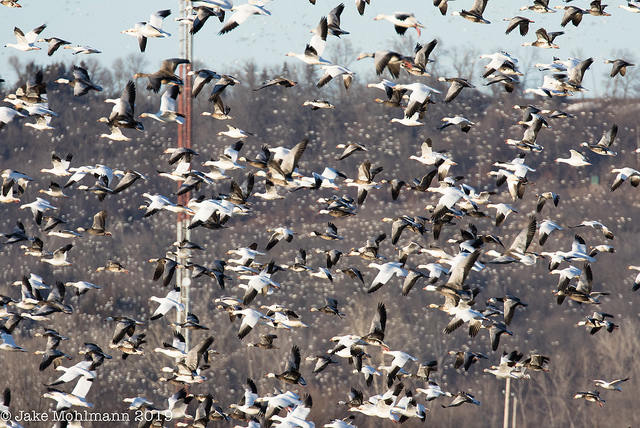
Droves of Snow Geese abound this week.
Sandhill Cranes were abundant as we watched at sunset as many of the 300,000 estimated birds came pouring in overhead landing to roost along the Central Platte River. This is truly an indescribable experience that needs to be experienced to be believed!
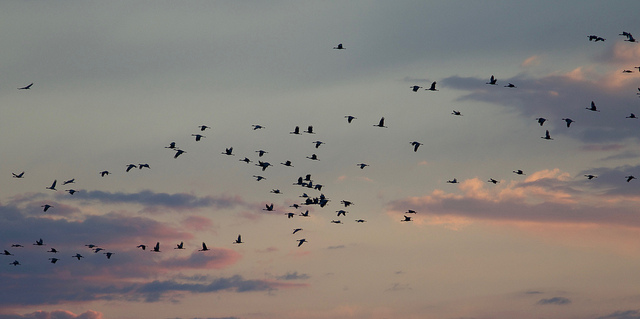
Thousands of Sandhill Cranes flyby at sunset.
Our last days led us to the famous Sandhill region of Central Nebraska, a feature that covers about ¼ of the state. Our main goal here was to view the extravagant courting rituals of Prairie Chickens and Sharp-tailed Grouse. We succeeded in capturing both of these mind-blowing phenomenon on film, at close range, from our cozy bus blind set amongst the rolling hills.
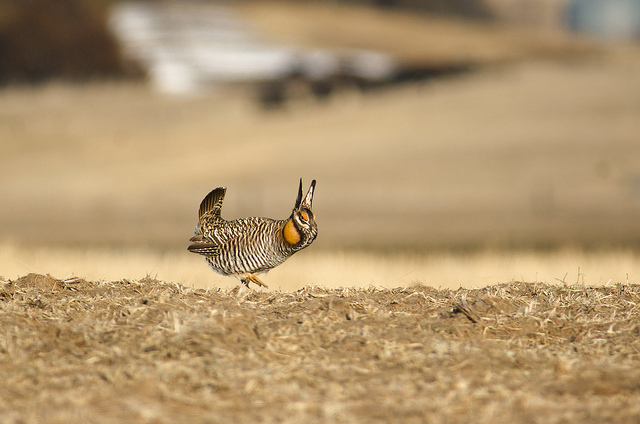
A male Greater Prairie Chicken in full display. Image: Ethan Kistler
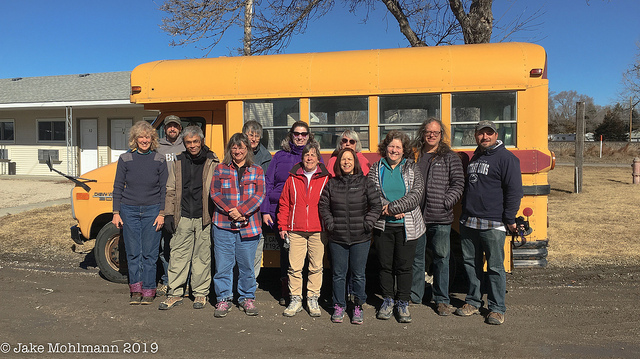
Group after witnessing Sharp-tailed Grouse displays.
March 11:
Gavin Bieber on the first of his irregular Outback Australia tours, Southwestern Australia and Northern Queensland
The first of what will be a series of irregular WINGS outback Australia tours wrapped up to critical acclaim. We began the three week journey with a fine week around the Southwest corner of the country where we located regional endemics like the...
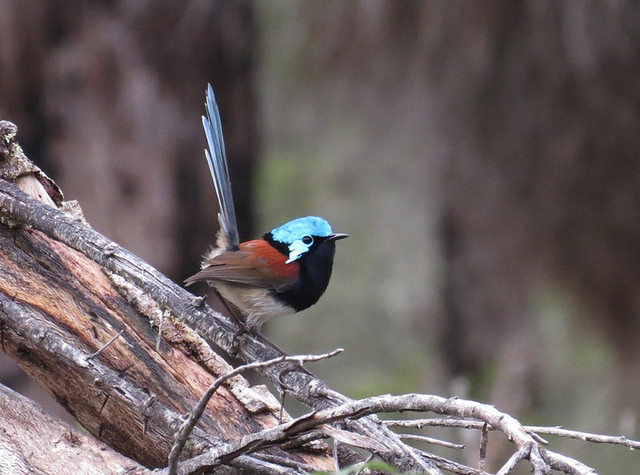
...incandescent Red-winged Fairy-Wren... (Image:Peter Taylor)
...striking White-breasted Robin... (Image: Peter Taylor)
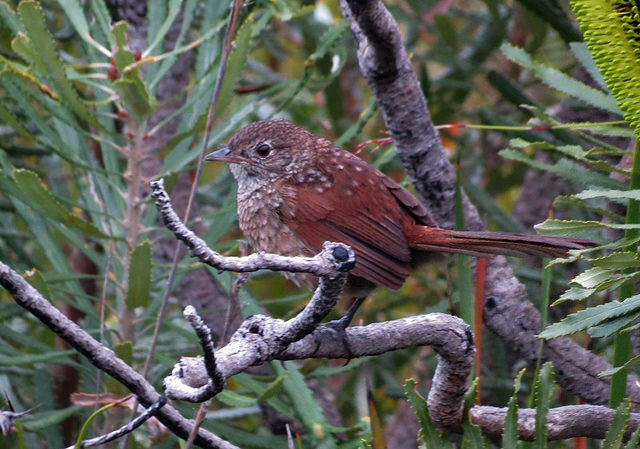
...and highly localized Western Bristlebird, here a juvenile. (Image: Peter Taylor)
We also were delighted by more widespread species such as...
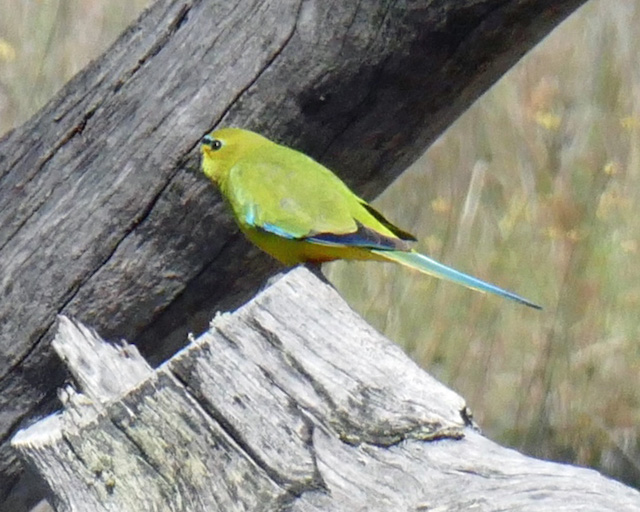
...this handsome Elegant Parrot... (Image: Bob Pease)
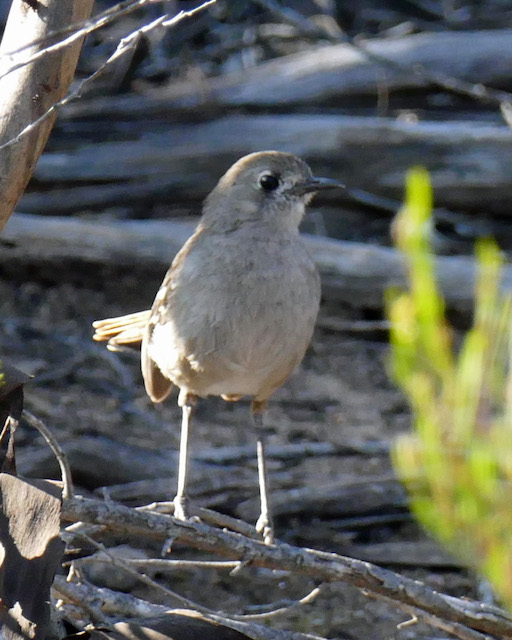
...the skulking Southern Scrub-Robin... (Image: Bob Pease)
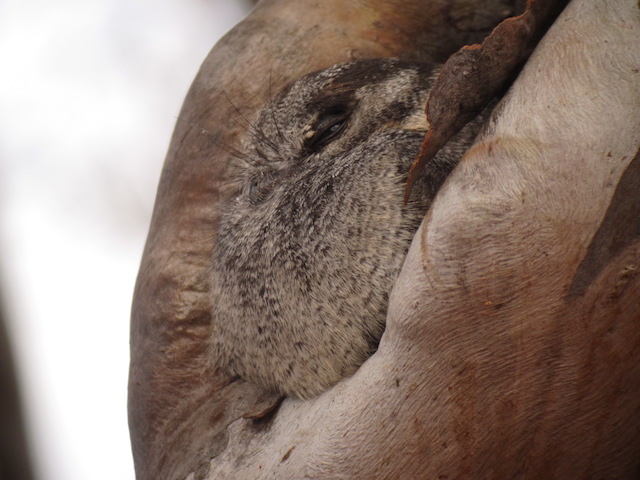
...and the undeniably cute Australian Owlet-Nightjar (Image: Bob Pease).
We then moved on to the red heart of the country amid the timeless McDonnell Ranges around Alice Springs. We found the summer heat to be intense, but not too dissimilar to that of America’s desert Southwest. Although conditions were dry, heavy rains a few months prior to our visit had brought in a wealth of irruptive species like this...
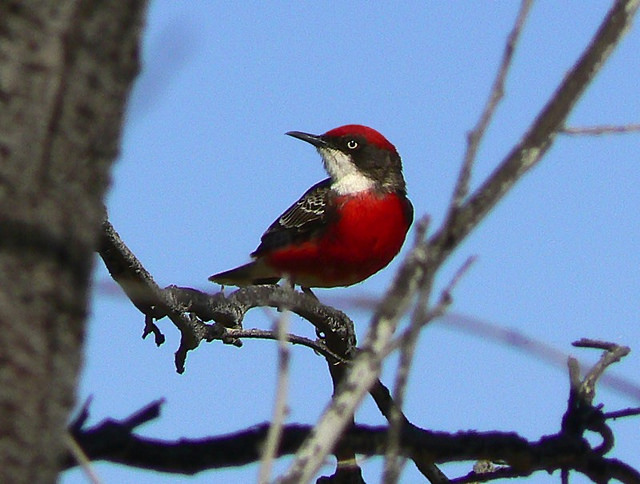
...handsome Crimson Chat... (Image: David Fisher)
...and the resident birds like...
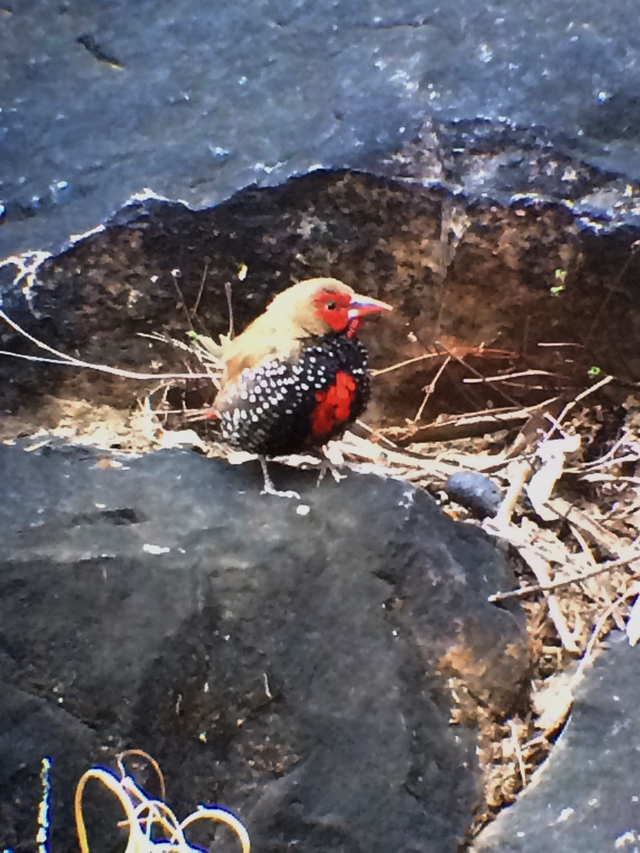
...Painted Finch... (Image: Gavin Bieber)
...
...and Spinifexbird were still in good and vocal form. (Image Ann Urlanda)
March 8:
Steve Howell and Fabrice Schmitt on their recent cruise, Around Cape Horn - Santiago, Chile to Buenos Aires, Argentina
As usual this trip was a great mix of seabirding and landbirding. From huge Wandering Albatrosses to the tiny and enigmatic Pincoya Storm-Petrel, and from magnificent Magellanic Woodpeckers to elusive tapaculos, each day produced something special. Our at-sea day south of Chacabuco was undoubtedly ‘day of the albatross,’ with six species around the ship all day...
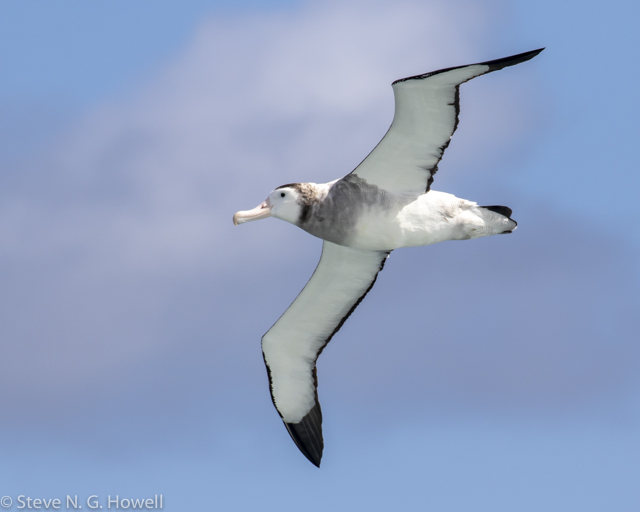
... including this female Antipodes Wandering Albatrosses sailing at eye level from Deck 15!
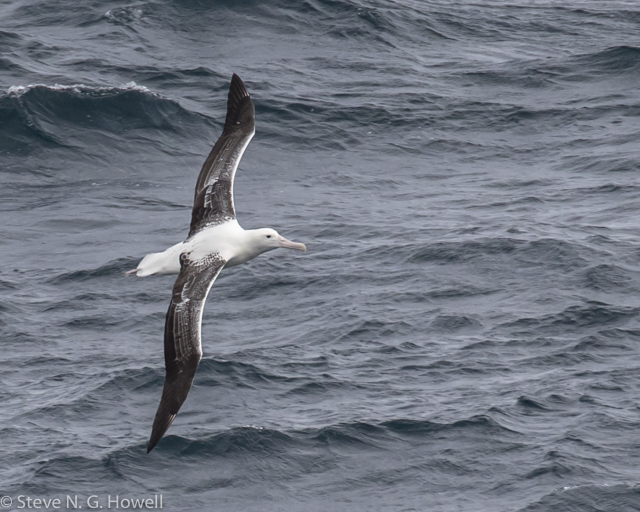
Plus both Southern (here) and Northern Royal Albatrosses regularly cruising past the bow.
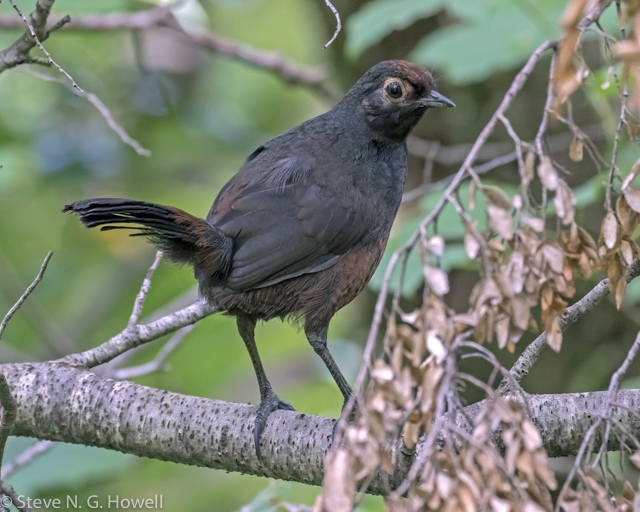
The day before we enjoyed scope views (yes, you heard correctly!) of the normally elusive Black-throated Huet-huet (pronounced wet-wet), a massive tapaculo
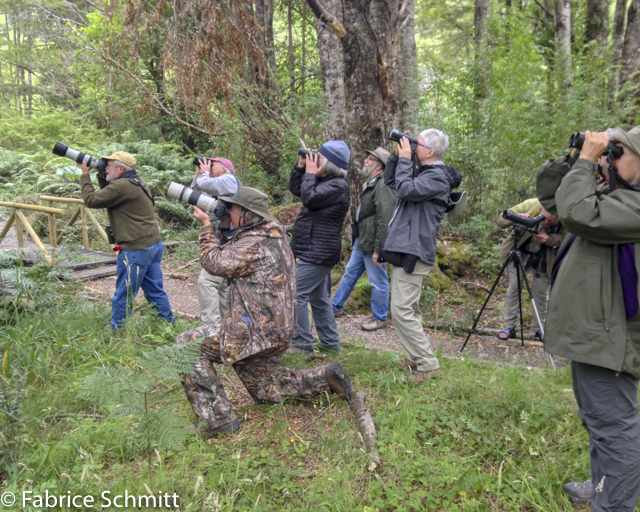
... here being stalked by the group...
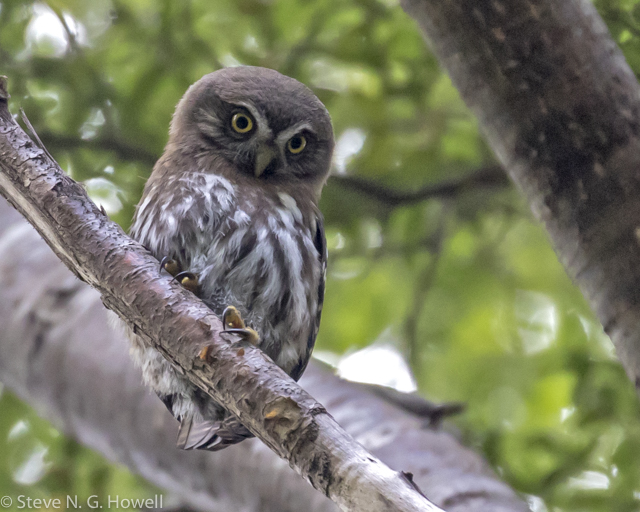
Plus an endearing young Austral Pygmy-Owl.
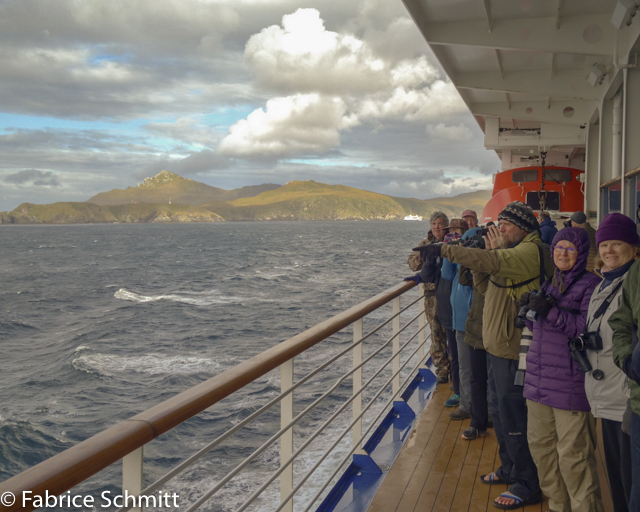
Rounding Cape Horn on a sunny but windy day, where we saw the southernmost Andean Condors sailing over ocean cliffs!
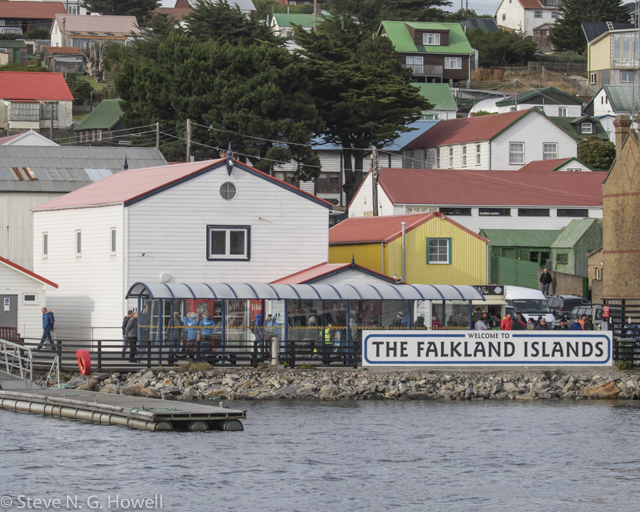
Our landing approach at the colorful Falkland Islands, where we visited the King Penguin colony and appreciated life at an island outpost.
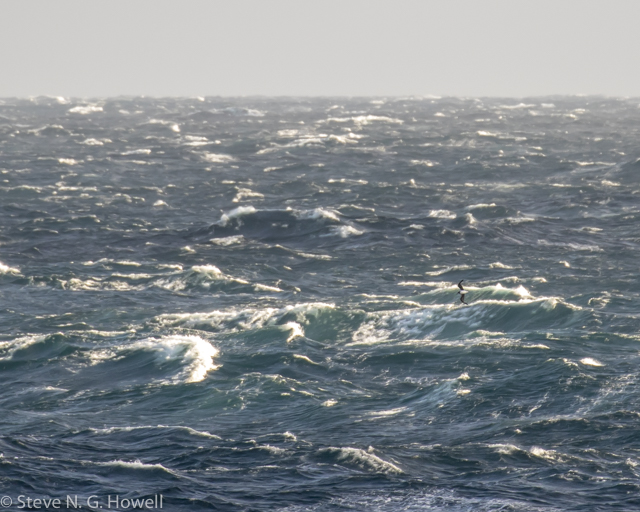
North of the Falklands, the stormy seas were coming from behind us, making for a very comfortable day of ‘unrelenting’ gadfly petrels—hundreds of Soft-plumaged and Atlantic Petrels around the ship all day. Here a Soft-plumaged Petrel ‘in habitat’ during the morning…
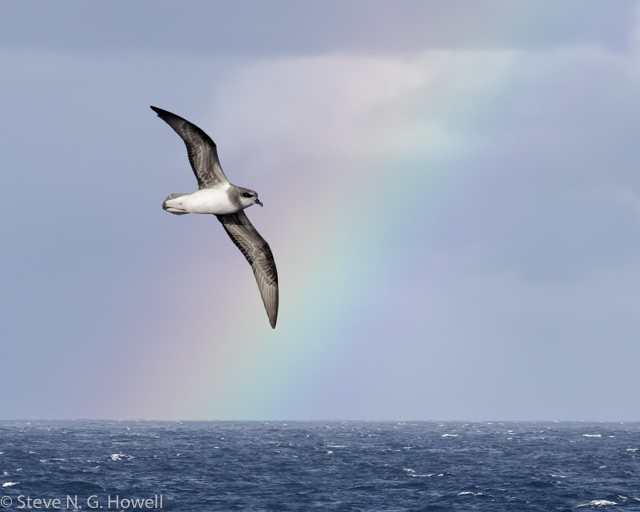
... and here another Soft-plumaged Petrel in the afternoon as the seas settled down.
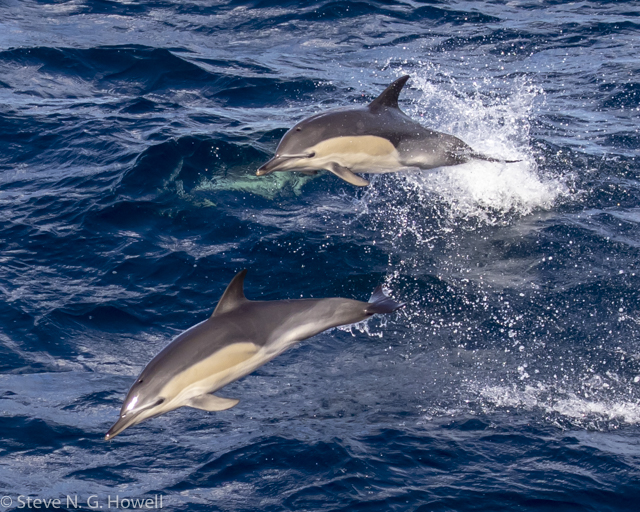
As we approached Uruguay, the sealife shifted again, with lots of Yellow-nosed Albatrosses and hundreds of Common Dolphins, marking the end of some remarkable seabirding.
February 23:
Jake Mohlmann on his and Evan Obercian's recently concluded tour, Texas: The Rio Grande Valley
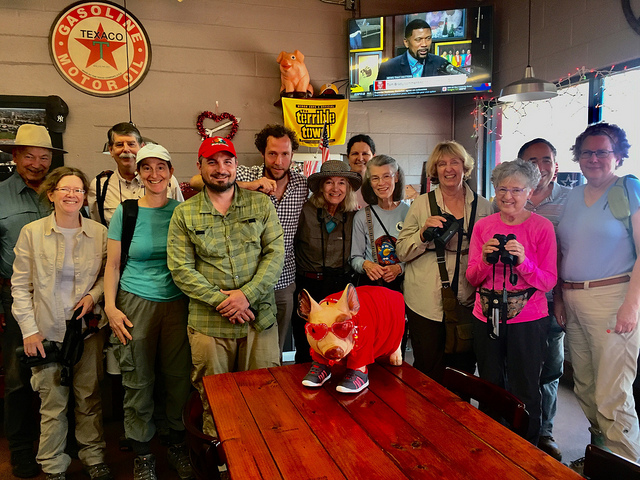
Our satiated group after a genuine Texas barbeque feast.
We just ended our latest tour through Texas's Lower Rio Grande Valley where 209 species of birds were seen around and over 1085 miles of border roads. We always hope our tour happens at a time when Mexican strays are being seen and this year didn’t disappoint. A Golden-crowned Warbler tested our bird finding abilities while a female Crimson-collared Grosbeak stole the show at Quinta Mazatlan.
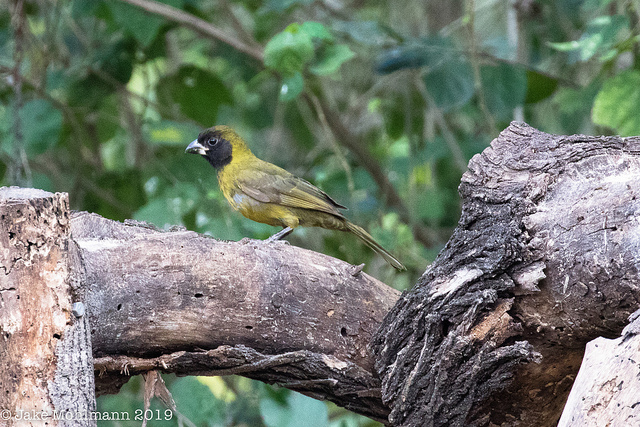
A rare Crimson-collared Grosbeak showed nicely.
Valley specialties were in abundance this year. Good numbers of Groove-billed Anis were utilizing the shrubby arroyos. We saw two at the famed Estero Llano Grande and stumbled into a particularly confiding Audubon’s Oriole in Salineño.
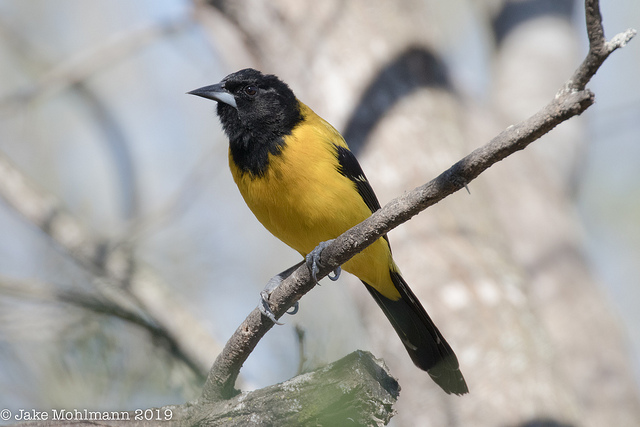
An Audubon’s Oriole came in for close inspection.
Waterfowl species numbered 23 and included such delights as thousands of Black-bellied Whistling Ducks, Ross’s Geese, and several diminutive Least Grebes.
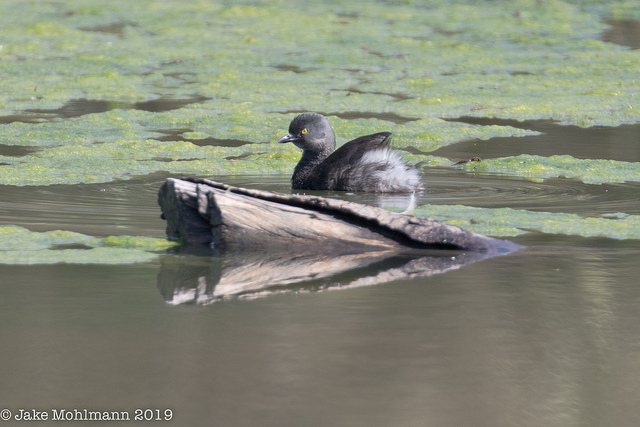
This Least Grebe was a showstopper.
We searched far and wide and found some hard to find species including LeConte’s Sparrow posing in the open, tiny Northern Beardless-Tyrannulets, a bright Yellow-throated Warbler, and a very secretive Sprague’s Pipit that finally showed well.
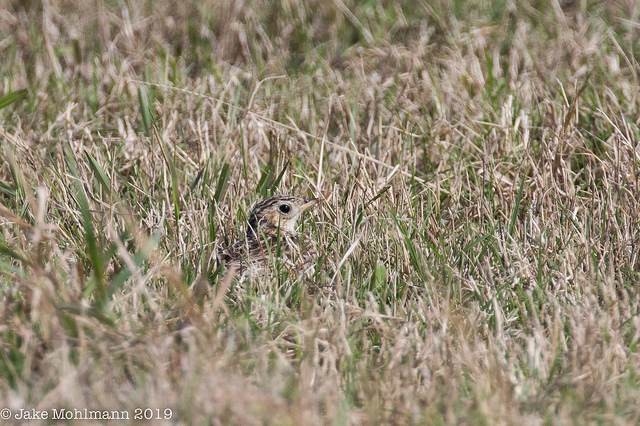
Sprague’s Pipit takes time to see but is well worth it
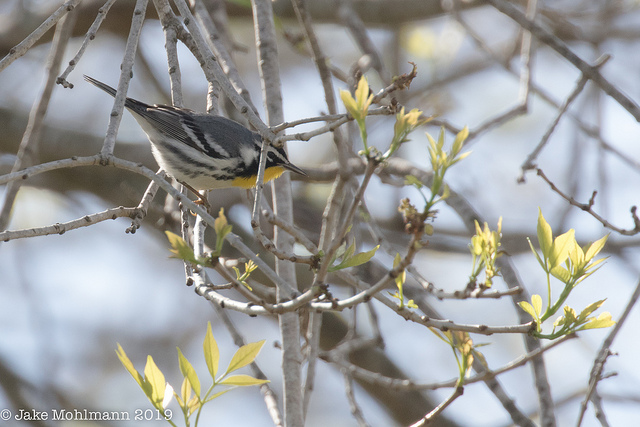
Yellow-throated Warbler in the early budding trees.

Jake upper left, LeConte's Sparrow lower right, both in focus. Surely a first... Image: Ro Carlisle
Surveying the extensive wetlands on South Padre Island is always an exciting experience. Shorebirds like Lesser and Greater Yellowlegs posed for nice comparisons, bright pink Roseate Spoonbills glowed in the waning light, and waders like Reddish Egrets and Tricolored Herons foraged in the shallows below our feet.
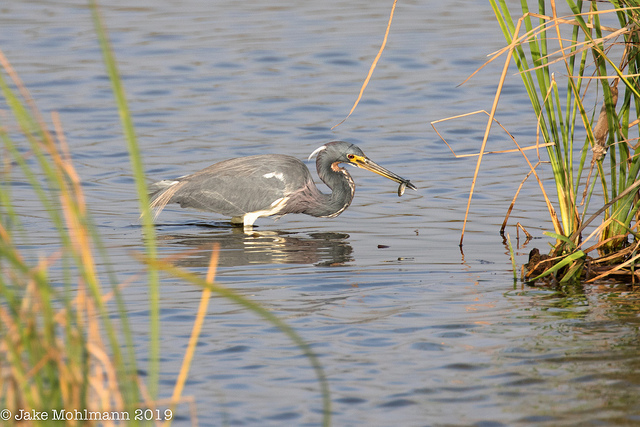
This Tricolored Heron wreaked havoc on a school of minnows.
The extension focused on seeing the endangered Whooping Cranes at Aransas National Wildlife Refuge. We witnessed a rarely seen behavior when an adult crane fed its mate a plump blue crab, and were thrilled when the boat pulled up right next to a family as they foraged for their favorite food source in the salt marsh.
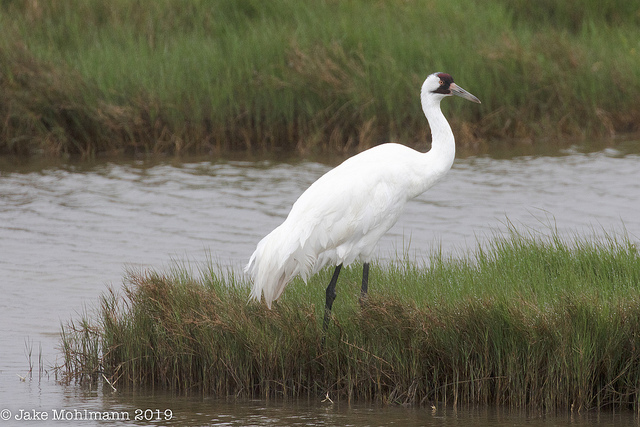
Extremely close views of the rare Whooping Crane.
February 21:
Jon Feenstra on his recently concluded tour, Ecuador: The East Slope of the Andes
We just finished a short six day tour down the Amazon slope of the Andes in northern Ecuador. The weather was mostly good, the birding was top notch, and we ate many great meals in some posh lodges. Highlights were many but most people thought that the near-simultaneous appearance of both Crested and Golden-headed Quetzals was pretty special, and our 37 species of hummingbirds was quite nice, too!
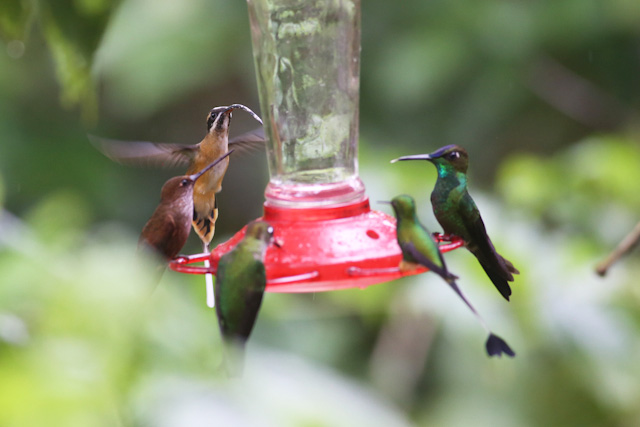
Here, five species of hummingbird visit a feeder in a poorly-veiled peace agreement.
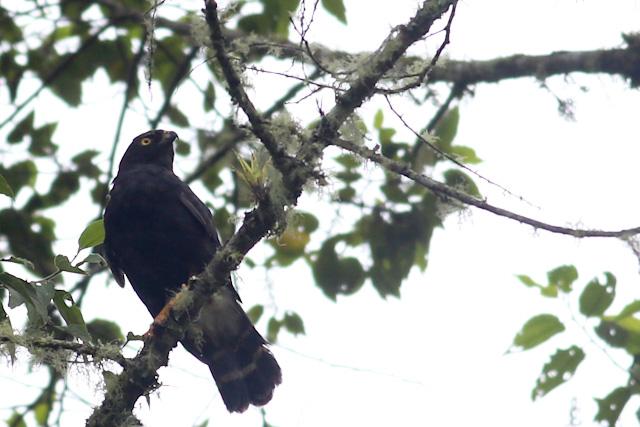
A White-rumped Hawk perches in a tree above us. Surprisingly, during the tour, we encountered three of these sharp-looking small forest hawks. A record?
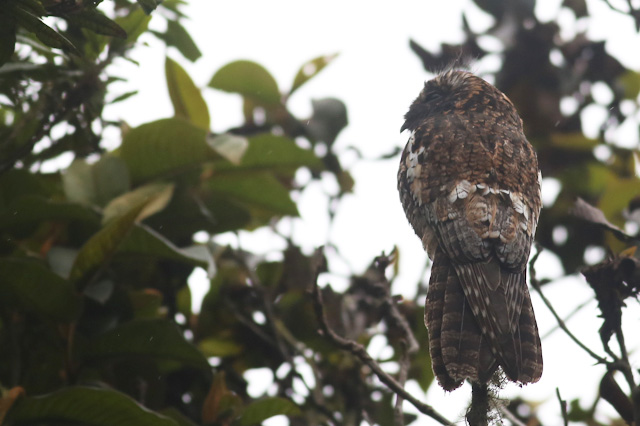
An Andean Potoo sits out on a day roost along a trail near Guango Lodge.
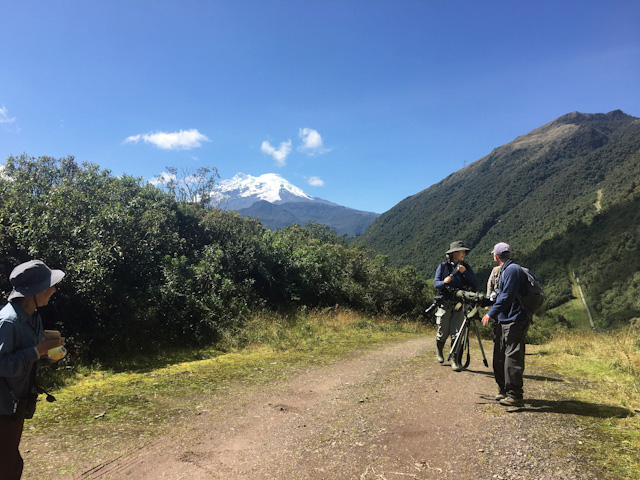
A few of the group admire Volcan Antisana. It isn't too often that a view like this happens!

